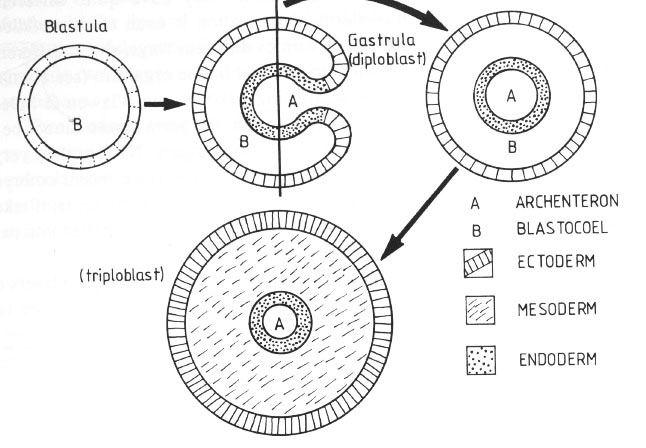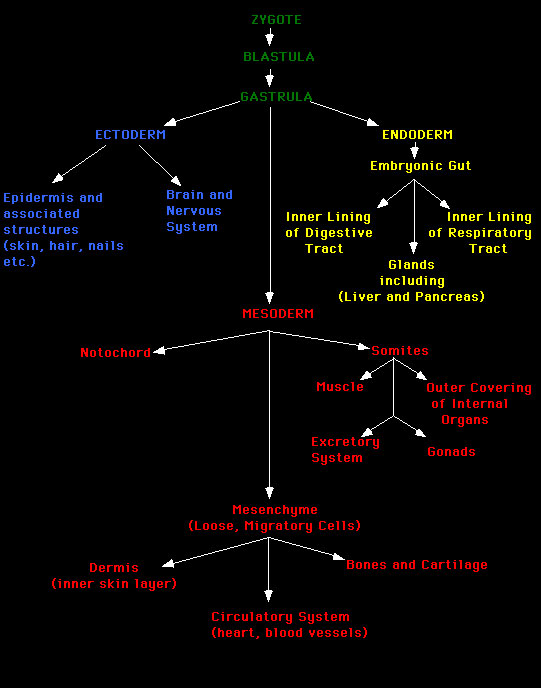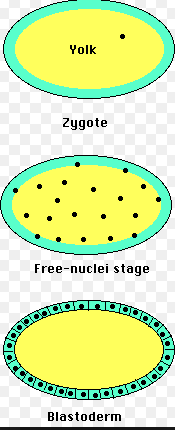Multicellular animals are know as Metazoa. Multicellularity is correlated with the development of tissues.
It is a way of introducing efficiency into design,
Most animals contain true tissues or aggregations of morphologically and physiologically similar cells that perform a specific function.
Some small phyla such as the Placozoa and Porifera (sponges ) are believed to not have true tissues or poorly developed tissues.
Eumetazoa are true tissue grade animals and include most phyla (crown clades)
Animals are classified as diploblastic or triploblastic.
Germ layers initially form as outer and inner sheets of masses of embryonic tissue or ectoderm and endoderm. Two higher clades or phyla Cnidaria (hydroids and jellyfish) and Ctenophora have only these two layers. In adults these two layers give rise to protective structures and digestive (feeding) structures.
Most other higher clades (phyla) have three layers and are triploblastic. Mesoderm is found between ectoderm and endoderm. The process by which cells from the outside move into the inside eventually giving rise to endoderm and mesoderm is called gastrulation. Gastrulation is a major development event involving significant cell rearrangement. If such does not occur all development stops.
-------------------------------------------------------------------------------------------------
The diagram above shows gastrulation in the frog, where a hollow blastula with its cavity called a blastocoel, gives rise to a three layer gastrula. A new cavity develops as cells move inward, the archenteron, which will become the gut in many animals.
--------------------------------------------------------------------------------------------------
Mesoderm gives rise to connective tissue and muscle, essentially most structures in an animal. It allows more potential for a more complex bauplan.
______________________________________________________________
But there are problems identifying these layers in all animals.
Ideas regarding mesoderm are derived from studies on vertebrates and invertebrates that are closely related to vertebrates, such as sea urchins.
But blastulas and gastrulas do not always form in the same way in different animals.
________________________________________________________
Two real life examples:
In insects in general, blastulas form by nuclei moving to the periphery and there giving rise to cells
.
Drosophila: The Drosophila embryo is more cigar-shaped than spherical, and gastrulation occurs along a ventral seam; below are cross-sections through the tube of the embryo's body.
What you can see is that a plate of cells buckles inward and the cells roll inward as a sheet. The sheet then collapses into a mesenchymal mass that will contribute to the mesoderm of the embryo. You do not see an endodermic layer. The tube of the gut arises from invaginations at the anterior and posterior ends .
So, often it is difficult to determine three distinct layers in embryos of different animals.
_________________________________________________________
So if organisms have the organs associated with mesoderm, we assume they are triploblastic no matter what we can see happening during development.
Taxonomists used other differences in development to distinguish phyla (crown clades). This lead to the no longer held notion of two main lines, protostomes and deuterostomes, of bilateral triploblastic animals.
Above diagram, shows some of the developmental differences used to distinguish invertebrate groups in older texts, and unfortunately, even current introductory texts. Protostome is a term we will not use, and so you do not have to know the developmental differences between protostomes and deuterostomes.
The major problem is that again most of these differences do not exist in the most common members of each major line. Vertebrates that are deuterostomes do not show all the characteristics of deuterostome development. We have learned that insects, which are common protostomes, do not show radial cleavage, or the typical gastrulation and gut formation patterns, ascribed to protostomes.
Despite wildly different phylogenetic scenarios espoused by different workers, the distinction of deuterostomes and other invertebrates has been relatively well supported, but because of DNA similarities, not developmental homologies. However, the protostomes are very diverse and most are not at all closely related. Most do not exhibit all of the characteristics of "protostomes." Most texts are now advocating abandoning the term. We will not be using the term protostome, and instead recognize three major branches of invertebrate evolution and relatedness, Deterostomes, Ecdysozoans and Lophotrochozoans. Many phyla (crown clades) we will study will also not be closely related to members of these major lines. They may represent independent lines from some ancestor that have survived from when most most crown clades (phyla) appeared during the Cambrian, about 540 million years ago. More on these lines next week when we examine classification of invertebrates.




